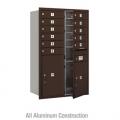Combat Identity Theft with High Security Commercial Mailboxes
USPS Approved Mailboxes Adhere to Strict Security Regulations
The U.S. Postal Service has stepped up its regulations in an effort to discourage identity theft incidents. Over the past decade the introduction of specification 1118-F for cluster box units and USPS-STD-4C for 4C horizontal mailboxes has required centralized mailbox manufacturers to submit their mailboxes to postal engineering to gain USPS certification. Numerous stringent tests are performed on the mailboxes with the security of cluster mailboxes being paramount.
Cluster box units were first introduced to the marketplace in the late 1990s with the Postal Service’s primary motivation being to remove the Neighborhood and Delivery Collection Box (NDCBU) from the marketplace. The NDCBU continued to exist in the marketplace for several years for economic and flexibility reasons. The Postal Service was aggressive in enforcing the cluster box unit regulations due to what they believed and was an inferior product in terms of security and other features. The NDCBU construction was less robust and the pry points were far greater than the newly designed cluster box units. In addition, the cluster box resident locks were stronger than the weak cam locks that the NDCBU offered. The Postal Service further emphasized security of the mail with the new 1118-F cluster box unit to replace the E Series cluster box early in the 21st century. In addition, the Postal Service Ins pection Service worked with one manufacturer to manufacture a cluster box that is known in the marketplace as a high security cluster box unit which further protects customers in high crime or other areas if needed or desired.
pection Service worked with one manufacturer to manufacture a cluster box that is known in the marketplace as a high security cluster box unit which further protects customers in high crime or other areas if needed or desired.
4C horizontal mailboxes were introduced to the marketplace in 2006 to gradually phase out horizontal mailboxes in the marketplace. The reasons noted by the USPS and other industry professionals for this change for wall installation receptacles was security of the mail, larger tenant doors, and built in package lockers to meet the parcel locker to tenant ratio required by the USPS. The security of 4C mailboxes was achieved with a more robust construction, minimal pry points, stronger tenant locks, outgoing mail and carrier access door protection with saw tooth plate and more. Customers often remark on heavy and thick the construction is when they receive their 4C mailbox shipment. Unwanted thieves are often discouraged when they come across to a 4C mailbox installation because of the nearly seamless design to prevent crowbar prying. Another additional surprise awaits the unwanted visitors when they realize the resident door cam locks hook into the frame of 4C mailbox. Finally, the Postal Service replicated the cluster box feature of protecting the outgoing mail and main access door by requiring in the specification the anti-fish plate with a saw tooth design.
There are other commercial mailboxes available in marketplace like vertical and horizontal mailboxes, however in terms of security they pale in comparison to the CBU and 4C receptacles. Furthermore, the designs of the horizontal and vertical mailboxes were made decades ago and are not nearly as advanced in terms of tolerances, materials and engineering.

 Submit Project Specs & Plans Here
Submit Project Specs & Plans Here